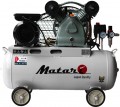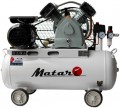Add to comparison |  |  |
|---|---|---|
| Matari M340B22-1 50 L | Matari M290B22-1 50 L | |
from $398.00 up to $447.20 | from $370.24 up to $416.00 | |
| User reviews | ||
| TOP sellers | ||
Multipoint connection. Motor protection IP 54. Nominal pressure 10 bar. High efficiency. Pressure switch Condor. In the model M290B22-1, the volume of the receiver is 50 L, and in the model M290C22-1 — 100 L | ||
| Compressor type | piston | piston |
| Design | oil-lubricated | oil-lubricated |
| Drive | belt | belt |
Specs | ||
| Input performance | 420 L/min | 360 L/min |
| Output performance | 340 L/min | 290 L/min |
| Rated pressure | 10 bar | 10 bar |
| Power | 2.2 kW | 2.2 kW |
| Number of cylinders | 2 | 2 |
| Number of steps | 1 | 1 |
| Receiver | horizontal | horizontal |
| Receiver volume | 50 L | 50 L |
| Power source | mains (230 V) | mains (230 V) |
General | ||
| Design features | transportation wheels | transportation wheels |
| Dimensions | 89.5x43.5x72.5 cm | 89.5x43.5x72.5 cm |
| Weight | 61 kg | 59 kg |
| Added to E-Catalog | january 2017 | january 2017 |